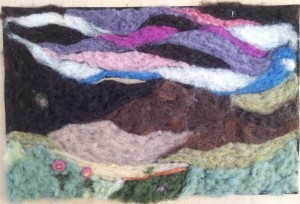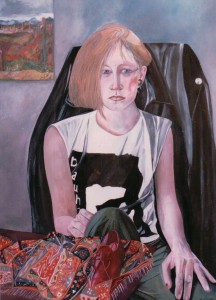Moms congregating in groups at parks, breastfeeding support groups, and cafes often find themselves trading stories about “Mommy brain.” You know, B.B. (before baby) you were a high-ranking partner at a law firm and now you can’t remember where you stashed your favorite nursing bra. B.B. you aced calculus and now you stare blankly at a restaurant receipt, trying to remember how to calculate a tip. B.B. you never missed an appointment, but now you’ve rescheduled your haircut twice because it’s not like you were actually doing anything important, but somehow you managed to forget the only hour you’ve had to yourself in the last three weeks…twice.

You know how most of the time changes like these can go unnoticed, but every once in a while a ghost of your former self comes out to haunt you? That happened to me the other day. I was going through all my various 3-ring binders that I keep music in. Rather than having any sort of logical system (an idea I’d love to bring about but never have), my music binders tend to represent me at various stages in my life.
So I pulled out the binder I used the last time I performed live in a singing/guitar duo. I have no trouble remembering that time: I was hugely pregnant the last time we performed. My singing partner at the time and I had discovered that by random chance, we’d been born in the same town, so we named our little band after the town. I truly meant to get back to performing after the birth, but at 7 months pregnant, I was swollen up so much that my hands had gone into full-blown carpal tunnel syndrome (which my physician assured me would go away after birth, ha ha ha). Somehow, that return to performing never happened, and now that baby I was pregnant with is fifteen years old.
How did that happen? Mommy brain…
Anyway, here I was opening this binder, which was a little snapshot of who I was then, more than fifteen years ago. I was charmed by our playlist, which included a couple of my favorite Disney songs (“Everybody wants to be a cat” and “Cruella deVille”).
But here’s where my realization about Mommy brain came in: Each sheet had the words printed out, and some notes about how we were performing, but no chords. I rifled through the binder, amazed. Did I really perform without the chords written out?
Yes, apparently I did.
I’m in the midst of getting my song-singing chops back, fifteen years on with two kids, carpal tunnel surgery, and the painful process of creating new guitar calluses behind me. The lime green skirt is long gone, along with any expectation that I will ever again fit into a miniskirt, or dare to think I look good in one.
But it’s hard to see that despite what research might say, Mommy brain in my case is real: I really did perform without chords when last I performed. And when I was twenty and singing out on that patio, I apparently had memorized the words as well.
The best wisdom I have read about aging is that it’s important to remember that along with what we lose (chord progressions, words, our favorite nursing bra), we gain (insight, perspective, depth of understanding, appreciation for clothing that stretches and hides).
But when these occasional reminders come about, I can’t help but be a little sad for my loss. I used to be able to perform without chord progressions in my book. I used to be able to perform…without a book at all. I was good at calculus. (If Mommy brain hasn’t ruined me completely, I seem to remember I got an A+.) I did manage to hold everything important in my life inside my physical brain, before Evernote, cellphones, and even Google.
Now there seems to be so much—two kids’ schedules, a whole family’s needs—that I can’t stuff it all in there.
 I just hope that when I get back out there with my new singing partner (who, as far as I know, wasn’t born in the same town I was), people will forgive us. Here we are, two post-baby moms, hers out of the house and mine plummeting headlong toward that end, making music and loving it.
I just hope that when I get back out there with my new singing partner (who, as far as I know, wasn’t born in the same town I was), people will forgive us. Here we are, two post-baby moms, hers out of the house and mine plummeting headlong toward that end, making music and loving it.
If nothing else, give us a little applause for getting up there.
In spite of Mommy brain, we managed to find our car keys.






